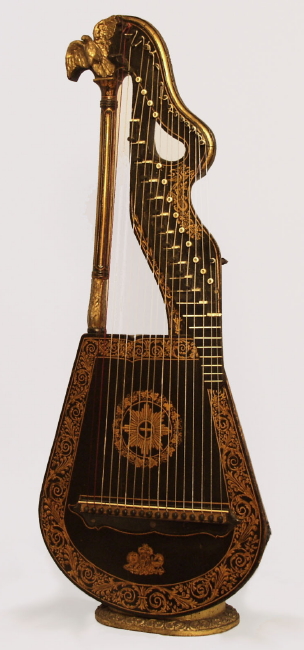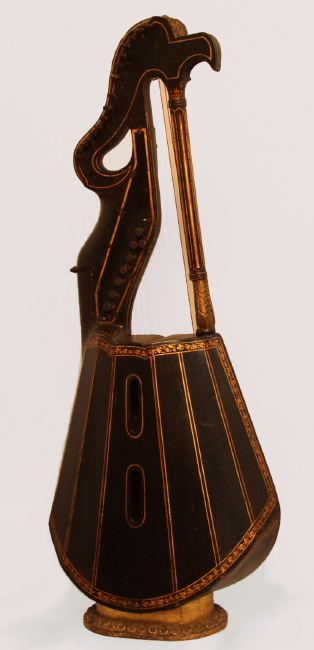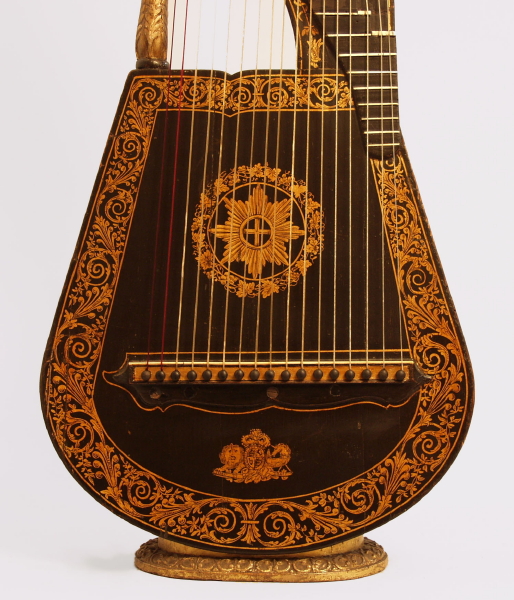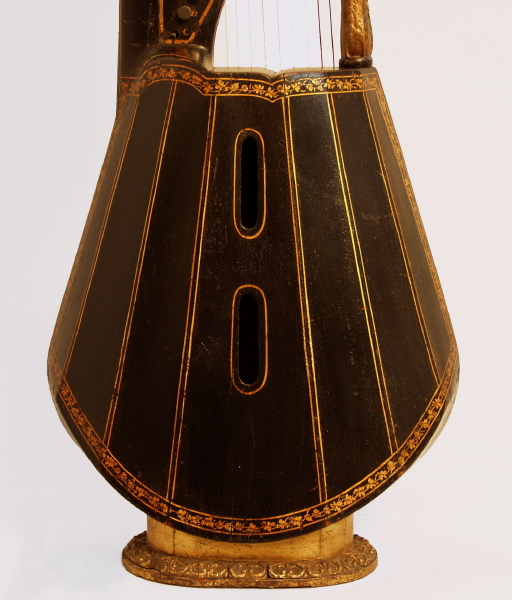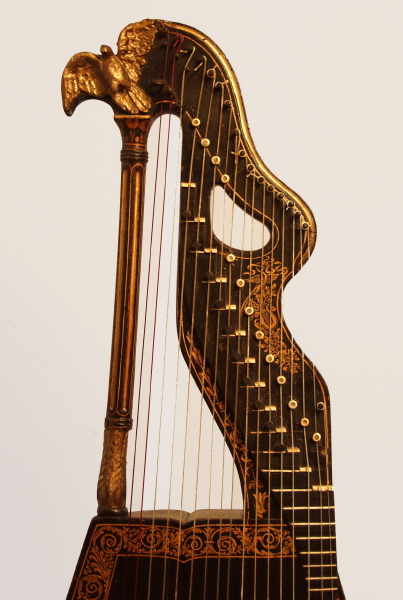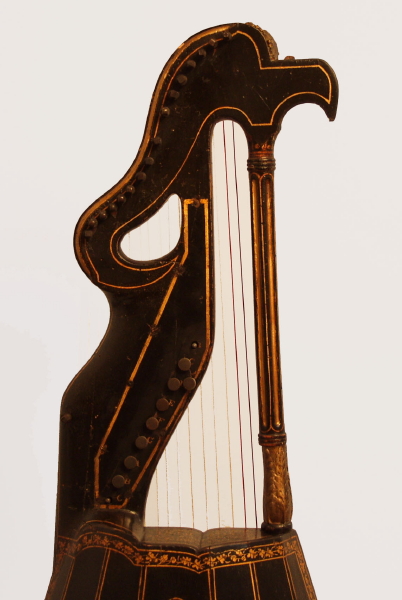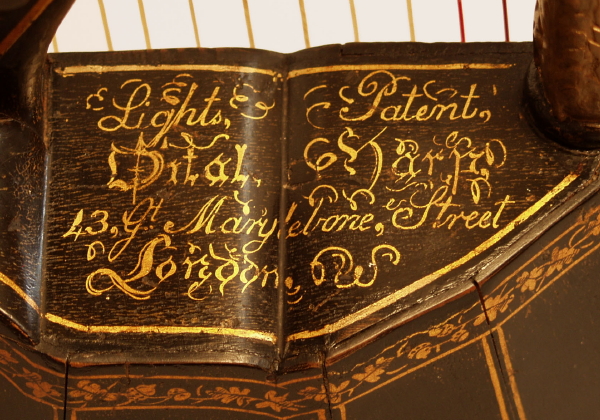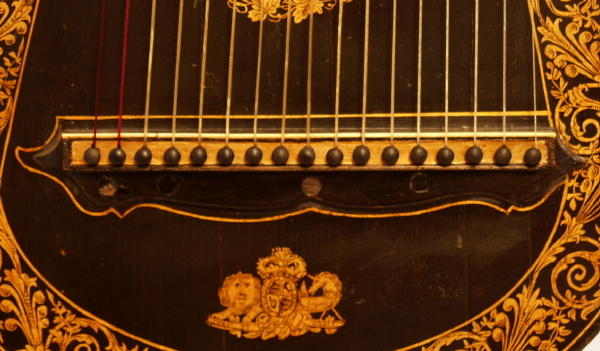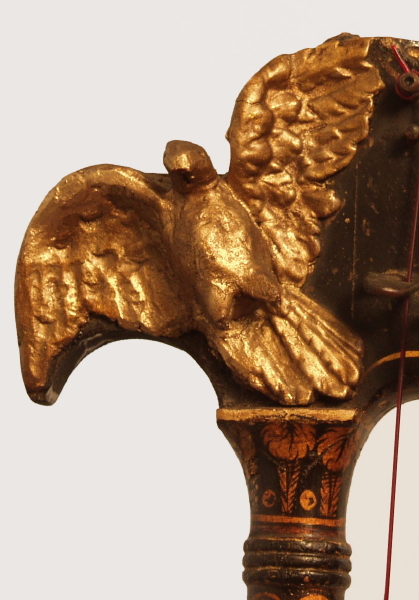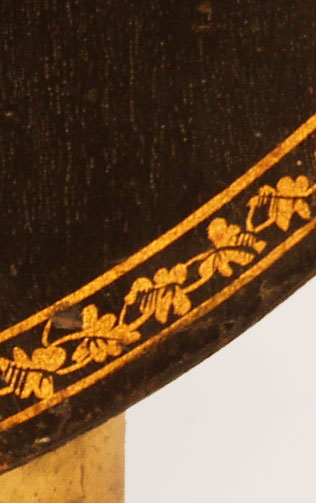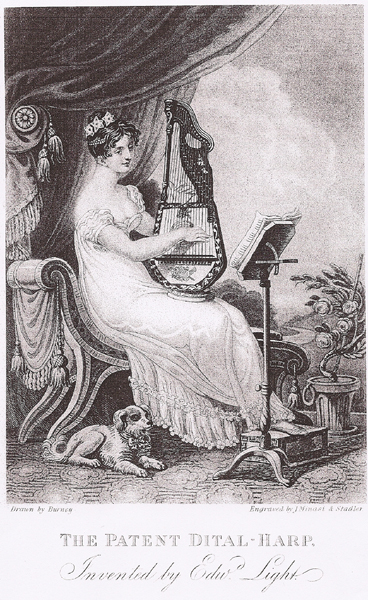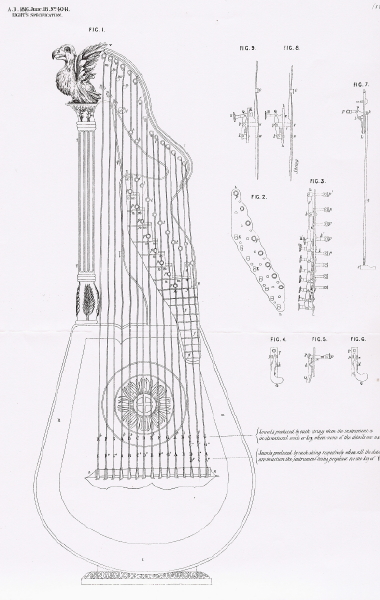A. Barry Light's Patent Dital Harp , c. 1825
This item has been sold.
Item # 3220
Prices subject to change without notice.
A. Barry Light's Patent Dital Harp, c. 1825, made in London, ebonized wood finish, ebonized wood, ivory and iron.
Here is an interesting example of the final and most complex step of the evolution of the harp lute, called the dital harp. The body bears hand painted gold script reading "Lights Patent Dital Harp 43. Gt. Marylebone Street London, W" on top edge behind neck. Harp-style column on the bass side and short fretted lute neck with wide fingerboard on the treble side.
The entire instrument is decorated with scrolling grape vines, acanthus leaves, musical trophies, and the British Royal Arms. The column is surmounted by a bird in flight which was probably added shortly after the instrument was made. This instrument has a seven stave curved back with double slot shaped sound hole at center. Seventeen gut strings with ten ditals.
Edward Light, 1747-1832, was an inventor, composer, and organist who patented this British harp lute, later called the dital harp, in 1816. That same year he published "The New and Complete Directory to the Art of Playing on the Patent British Lute Harp". Similar to the extant example in London's Victoria and Albert Museum, this unique instrument was first publicized in 1815. The harp lute, and somewhat more common six string lyre-guitar and harp-guitar, were considered at the height of style for a brief period "reflecting times when ladies' fashions extended to small musical instruments, in this case married to the neo-classical pose" (Baines).
Dr. Busby, in his "Concert Room Anecdotes" published in 1925, said, "This instrument is the most eligible accompaniment to the human voice". Thirty-one years earlier, he published "The Art of Playing the Guitar" and, in 1798, he invented a type of harp-guitar. This was a guitar with the body shaped like that of a harp -- this later developed into the dital harp.
Robert Bruce Armstrong wrote in his book "English and Irish Musical Instruments, Edinburgh, 1908": "The Dital Harp is both in forma and tone, vastly superior to the Spanish guitar".
Height is 33 in. (83.8 cm.), 13 5/8 in. (34.6 cm.) width, and 4 1/2 in. (11.4 cm.) in depth at side, taken at the end block.
Recent restoration and re-touching of restoration gilding. Excellent Condition.
Here is an interesting example of the final and most complex step of the evolution of the harp lute, called the dital harp. The body bears hand painted gold script reading "Lights Patent Dital Harp 43. Gt. Marylebone Street London, W" on top edge behind neck. Harp-style column on the bass side and short fretted lute neck with wide fingerboard on the treble side.
The entire instrument is decorated with scrolling grape vines, acanthus leaves, musical trophies, and the British Royal Arms. The column is surmounted by a bird in flight which was probably added shortly after the instrument was made. This instrument has a seven stave curved back with double slot shaped sound hole at center. Seventeen gut strings with ten ditals.
Edward Light, 1747-1832, was an inventor, composer, and organist who patented this British harp lute, later called the dital harp, in 1816. That same year he published "The New and Complete Directory to the Art of Playing on the Patent British Lute Harp". Similar to the extant example in London's Victoria and Albert Museum, this unique instrument was first publicized in 1815. The harp lute, and somewhat more common six string lyre-guitar and harp-guitar, were considered at the height of style for a brief period "reflecting times when ladies' fashions extended to small musical instruments, in this case married to the neo-classical pose" (Baines).
Dr. Busby, in his "Concert Room Anecdotes" published in 1925, said, "This instrument is the most eligible accompaniment to the human voice". Thirty-one years earlier, he published "The Art of Playing the Guitar" and, in 1798, he invented a type of harp-guitar. This was a guitar with the body shaped like that of a harp -- this later developed into the dital harp.
Robert Bruce Armstrong wrote in his book "English and Irish Musical Instruments, Edinburgh, 1908": "The Dital Harp is both in forma and tone, vastly superior to the Spanish guitar".
Height is 33 in. (83.8 cm.), 13 5/8 in. (34.6 cm.) width, and 4 1/2 in. (11.4 cm.) in depth at side, taken at the end block.
Recent restoration and re-touching of restoration gilding. Excellent Condition.
